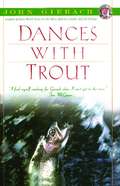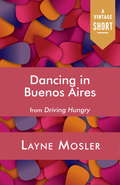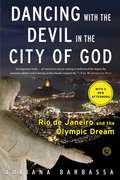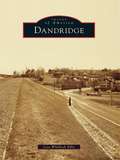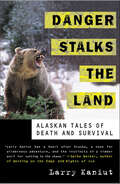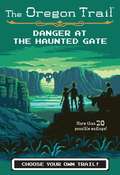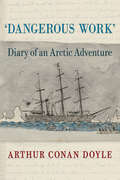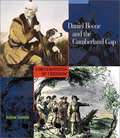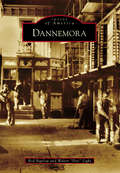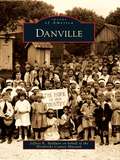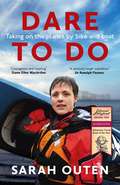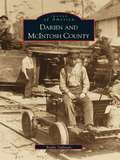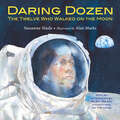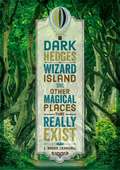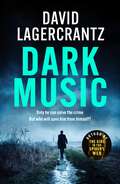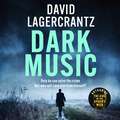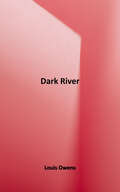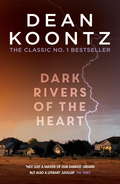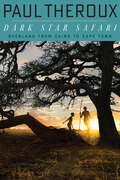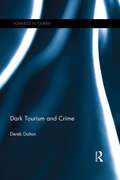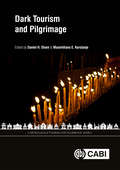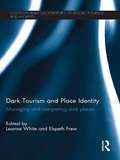- Table View
- List View
Dances with Trout
by John GierachWith the wry humor and wit that have become his trademark, John Gierach writes about his travels in search of good fishing and even better fish stories. In this new collection of essays on fishing -- and hunting -- Gierach discusses fishing for trout in Alaska, for salmon in Scotland and for almost anything in Texas. He offers his perceptive observations on the subject of ice-fishing, getting lost, fishing at night, tournaments and the fine art of tying flies. Gierach also shares his hunting technique, which involves reading a good book and looking up occasionally to see if any deer have wandered by. Always entertaining, often irreverent and illuminating, Gierach invites readers into his enviable way of life, and effortlessly sweeps them along.
Dancing in Buenos Aires
by Layne MoslerA Vintage Shorts Travel SelectionIn Dancing in Buenos Aires, Layne Mosler takes us on a unforgettable trip with a lively step. With grace, humor, and a keen eye for characters and detail, Mosler brings to life the soul of Buenos Aires and the dance that beats in its heart--the tango. From her first tentative steps (in flip-flops) to the legendary dance floor at Sunderland--the world's greatest tango club--Mosler comes to understand the soul of dance that is more than just movement, but a way of life. Sampling the city's incredible food and finding herself as a writer along the way, Mosler gives us an excursion of self-discovery you don't want to miss. An eBook short.
Dancing with the Devil in the City of God
by Juliana BarbassaIn the tradition of Detroit: An American Autopsy and Maximum City comes a deeply reported and beautifully written biography of the seductive and chaotic city of Rio de Janeiro from prizewinning journalist and Brazilian native Juliana Barbassa.Juliana Barbassa moved a great deal throughout her life, but Rio was always home. After twenty-one years abroad, she returned to find the city that once ravaged by inflation, drug wars, corrupt leaders, and dying neighborhoods was now on the precipice of a major change. Rio has always aspired to the pantheon of global capitals, and under the spotlight of the 2014 World Cup and the 2016 Olympic Games it seems that its moment has come. But in order to prepare itself for the world stage, Rio must vanquish the entrenched problems that Barbassa recalls from her childhood. Turning this beautiful but deeply flawed place into a predictable, pristine showcase of the best that Brazil has to offer in just a few years is a tall order--and with the whole world watching, the stakes couldn't be higher. With a cast of larger-than-life characters who are driving this fast-moving juggernaut or who risk getting caught in its gears, this kaleidoscopic portrait of Rio introduces the reader to the people who make up this city of extremes, revealing their aspirations and their grit, their violence, their hungers and their splendor, and shedding light on the future of this city they are building together. Dancing with the Devil in the City of God is an insider perspective into a city on the brink from a native daughter whose life, hopes, and fortunes are entwined with those of the city she portrays.
Dandridge (Images of America)
by Lisa Whillock EllisDandridge, Tennessee, the second-oldest town in the state, was founded in 1783 by a group of Scotch-Irish settlers. It was 13 years before Tennessee became the 16th state. The town began as a small frontier settlement along the banks of the French Broad River in the short-lived state of Franklin. In 1793, Dandridge became the county seat for the newly formed Jefferson County. The county was named for then U.S. secretary of state Thomas Jefferson. Dandridge is the only town in the United States named for first lady Martha Dandridge Custis Washington. Davy Crockett married his first wife near Dandridge, and the courthouse still has his marriage bond in its archives. Over the years, it has played host to presidents Andrew Jackson, James K. Polk, and Andrew Johnson. During the Civil War, the Battle of Dandridge was fought there in winter 1864. In 1942, the town was saved when the Tennessee Valley Authority built a dike to protect it from the waters of Douglas Lake.
Danger Stalks the Land: Alaskan Tales of Death and Survival
by Larry KaniutAlaska is like no other state and few countries; men experience greater risk in her arms. This one-of-a-kind anthology captures the spine tingling adventures of daring men and women who venture into Alaska's vast wilderness and look death in the eye. Danger Stalks the Land relates gripping episodes of animal attacks, avalanches, aircraft disasters, fishing, hunting, and skiing accidents, and chronicles risky climbs and reckless mountaineering amid Alaska's fantastic peaks. Through exhaustive research and interviews, author Larry Kaniut has captured in one volume, the terror and beauty of man's attempt to explore a vast and unforgiving land.
Danger at the Haunted Gate (The Oregon Trail #2)
by Jesse WileyContinue west, young pioneer—the second leg of your journey starts here—and it won't be any easier. Natural disasters, disease, and dishonest people are challenges you'll face in the wild frontier. Now, trek on the Oregon Trail to Devil's Gate! This is the second installment of four books that will take you all the way to Oregon Territory—if you make the right choices. In book two of this exciting choose-your-own-adventure series, it's 1850 and you've been traveling for the past six weeks on foot for fifteen miles a day with your family, covered wagon full of supplies, and oxen. And congratulations—you made it to Chimney Rock. But your journey has just begun. You need to get to Devil's Gate, the halfway mark on your 2,000-mile journey west. Keep watch! Danger awaits on your way to those eerie cliffs. Which path will you choose in the face of danger? With twenty-two possible endings, choose wrong and you'll never make it to Devil's Gate. Choose right and blaze a trail that gets you closer to Oregon City!
Dangerous Work: Diary of an Arctic Adventure
by Sir Arthur Conan DoyleIn 1880 a young medical student named Arthur Conan Doyle embarked upon the "first real outstanding adventure" of his life, taking a berth as ship's surgeon on an Arctic whaler, the Hope. The voyage took him to unknown regions, showered him with dramatic and unexpected experiences, and plunged him into dangerous work on the ice floes of the Arctic seas. He tested himself, overcame the hardships, and, as he wrote later, "came of age at 80 degrees north latitude. " Conan Doyle's time in the Arctic provided powerful fuel for his growing ambitions as a writer. With a ghost story set in the Arctic wastes that he wrote shortly after his return, he established himself as a promising young writer. A subsequent magazine article laying out possible routes to the North Pole won him the respect of Arctic explorers. And he would call upon his shipboard experiences many times in the adventures of Sherlock Holmes, who was introduced in 1887's A Study in Scarlet. Out of sight for more than a century was a diary that Conan Doyle kept while aboard the whaler. Dangerous Work: Diary of an Arctic Adventure makes this account available for the first time. With humor and grace, Conan Doyle provides a vivid account of a long-vanished way of life at sea. His careful detailing of the experience of arctic whaling is equal parts fascinating and alarming, revealing the dark workings of the later days of the British whaling industry. In addition to the transcript of the diary, the e-book contains two nonfiction pieces by Doyle about his experiences; and two of his tales inspired by the journey. To the end of his life, Conan Doyle would look back on this experience with awe: "You stand on the very brink of the unknown," he declared, "and every duck that you shoot bears pebbles in its gizzard which come from a land which the maps know not. It was a strange and fascinating chapter of my life. " Only now can the legion of Conan Doyle fans read and enjoy that chapter.
Daniel Boone and the Cumberland Gap (Cornerstones of Freedom, 2nd Series)
by Andrew SantellaA biography of Daniel Boone, focusing on his efforts as a pioneer and trailblazer during America's westward expansion. Includes bibliographical references and index.
Dannemora
by Walter Pete" Light Rod BigelowThe discovery of iron ore near Chateaugay Lake in 1831 started the settlement later known as the town of Dannemora. In 1832, several local businessmen entered into partnership to mine the ore. St. John B.L. Skinner, a lawyer in Plattsburgh, owned most of the land and named it Dannemora. Dannemora's history is intertwined with iron ore and the development of the prison. The town is located in Clinton County in the foothills of Dannemora Mountain and is within the Blue Line, which marks the border of Adirondack Park. The prison is built on the side of the mountain, and a building to its right, which was the State Hospital for Insane Convicts, is now called the Annex. Surrounding Dannemora are Lyon Mountain, Chazy Lake, and Upper Chateaugay Lake.
Danny Dunn, Time Traveler
by Raymond Abrashkin Jay WilliamsTeenage novel about Danny and his friends going back in time to 1763 where they meet Ben Franklin! Their time machine breaks down. Will they be stranded in the past forever?
Danny Wallace and the Centre of the Universe
by Danny WallaceDanny Wallace wanted to write about a place so special and so crucial to our existence that it had never before been tackled: the Centre of the Universe. But then he realised that getting there might be a problem, and when he did, there'd probably be nothing much to write about. Until he heard about a manhole cover, on a small street, in a small town, tucked away in a remote part of Idaho.The manhole cover had been declared the Centre of the Universe. The mayor had the science to back it up. The town rejoiced.And the name of the town?Wallace.It was a cosmic coincidence Danny couldn't resist...
Danville
by Hendricks County Historical Museum Jeffrey K. BaldwinDanville, created in 1824 as the county seat of Hendricks County, was the hub of government, commerce, and agriculture. Farmers sold their crops in town and shopped there. As the agricultural economy diminished, Danville became home to workers commuting to Indianapolis. Danville residents have always valued education. On May 10, 1878, at the instigation of Prof. W. F. Harper of the Central Normal School of Ladoga, 50 farm wagons from Danville arrived at Ladoga and stole the whole school, including equipment, students, faculty, and baggage. Central Normal College was then installed in the facility previously housing the Hendricks County Seminary and the Danville Academy. From 1878 to 1951, Central Normal College was a Danville institution, turning out more than 75,000 graduates destined for leadership roles in education, business, law, and politics.
Danziger's Travels: Beyond Forbidden Frontiers
by Nick DanzigerA first-hand look at life along the old silk route, from a young British traveler who passes for a Muslim and lives with the locals from Iran to China.
Dare to Do: Taking on the planet by bike and boat
by Sarah OutenOn April 1, 2011, rower and adventurer Sarah Outen set off in her kayak from Tower Bridge for France. Her aim was simple: to circle the globe entirely under her own steam - cycling, kayaking and rowing across Europe, Asia, the Pacific, North America, the Atlantic and eventually home. A year later, Sarah was plucked from the Pacific ocean amid tropical storm Mawar, her boat broken, her spirit even more so.But that wasn't the end. Despite ill health and depression, giving up was not an option. So Sarah set off once more to finish what she had started, becoming the first woman to row solo from Japan to Alaska, as well as the first woman to row the mid-Pacific from West to East. She kayaked the treacherous Aleutian chain and cycled North America, before setting out on the Atlantic, despite the risk of another row-ending storm...Dare to Do is more than an adventure story. It is a story of the kindness of strangers and the spirit of travel; a story of the raw power of nature, of finding love in unexpected places, and of discovering your inner strength. It is about trying and failing, and trying again, and about how, even when all seems lost, you can find yourself.
Darien and McIntosh County
by Buddy SullivanFrom 1870 to 1920, McIntosh County, Georgia, was one of the most energetic communities on the southern coast. Its county seat, Darien, never had a population of more than 2,000 residents; yet, little Darien was, for a considerable time, the leading exporter of yellow pitch pine timber on theAtlantic Coast. Burned to ashes during the Civil War, Darienrose up and, with its timber booms and sawmills, took its place among the leading towns of the "New South" of the late nineteenth century. In this unique photographic retrospective of Darien and McIntosh County, over 200 images evoke generations past of dynamic, hard-working people. Pictured within these pages are timber barons, sawmill workers, railroad builders, and shrimp fishermen. They are depicted among views of the buildings and structures associated with an era that was the most active in the recorded history of the community, which dates back to the earliest days of the Georgia colony in 1736.
Daring Dozen: The Twelve Who Walked on the Moon
by Suzanne SladeA gorgeous introduction to the twelve brave men who have left footprints on the moon, just in time to celebrate the fiftieth anniversary of the first lunar landing.On July 20, 1969, Neil Armstrong took one small step and made history. Over the course of the next three-and-a-half years, twelve lunar explorers, including Alan Shepard and Gene Cernan, touched down on the moon's surface. Author and engineer Suzanne Slade reveals how the Apollo missions (1969-1972) built upon one another and led to important discoveries about our nearest neighbor in space. Back matter includes an afterword by Alan Bean (1932-2018), the fourth person to walk on the moon.
Dark Hedges, Wizard Island, and Other Magical Places That Really Exist
by L Rader CrandallFrom a lost city in the desert to a cave alight with thousands of glowworms, learn about some of the most unusual places on earth and the myths, legends, and history behind each of them!Looking at places like The Skeleton Coast in Namibia, Wizard Island in the United States, and The Fairy Tale Route in Germany, The Dark Hedges and Other Magical Places that Really Exist takes young readers on a journey around the world to real places that sound straight out of fantasy. Featuring both natural and man-made wonders, this travel book combines history and storytelling to explore the far reaches of the earth.
Dark Music: The gripping new thriller from the author of THE GIRL IN THE SPIDER'S WEB
by David LagercrantzA gripping new thriller from the bestselling author of THE GIRL IN THE SPIDER'S WEB"A classic murder mystery . . . one Holmes himself would have loved to solve" Independent"A nerve-racking political thriller with the most exciting detective duo in a long time. Bring on their next case" Romy Hausmann, author of Dear Child"A rich, engrossing novel" Literary ReviewThe launch of a new series inspired by Sherlock Holmes. A murder investigation brings together two unlikely allies in a race to uncover a shadowy international conspiracy.Professor Hans Rekke: born into a wealthy Stockholm family, world authority on interrogation techniques, capable of vertiginous feats of logic and observation . . . But he might just fall apart when the going gets tough, leading to substance abuse and despair.Micaela Vargas: community police officer, born to Chilean political refugees in a tough suburb, with two brothers on the shady side of the law.Vargas feels she has something to prove. She's tenacious and uncompromising, but she needs Rekke's unique mind to help her solve the case. Rekke has it all - wealth, reputation - but also a tendency to throw it all away. He needs Vargas to help him get back on an even keel so he can focus his mind on finding the killer before they're both silenced for good.Translated from the Swedish by Ian Giles
Dark Music: The gripping new thriller from the author of THE GIRL IN THE SPIDER'S WEB
by David LagercrantzA gripping new thriller from the bestselling author of THE GIRL IN THE SPIDER'S WEBThe launch of a new series inspired by Sherlock Holmes. A murder investigation brings together two unlikely allies in a race to uncover a shadowy international conspiracy.Professor Hans Rekke: born into a wealthy Stockholm family, world authority on interrogation techniques, capable of vertiginous feats of logic and observation . . . But he might just fall apart when the going gets tough, leading to substance abuse and despair.Micaela Vargas: community police officer, born to Chilean political refugees in a tough suburb, with two brothers on the shady side of the law.Vargas feels she has something to prove. She's tenacious and uncompromising, but she needs Rekke's unique mind to help her solve the case. Rekke has it all - wealth, reputation - but also a tendency to throw it all away. He needs Vargas to help him get back on an even keel so he can focus his mind on finding the killer before they're both silenced for good.Translated from the Swedish by Ian Giles(P) 2022 Quercus Editions Limited
Dark River: A Novel (American Indian Literature and Critical Studies Series)
by Louis OwensJacob Nashoba's journey has taken him from his Choctaw homeland in Mississippi to Vietnam and finally to a small reservation in the mountains of eastern Arizona. A tribal ranger, he lives among people far different from any he has known. Balanced precariously between isolation and community, he is drawn to both the fastness of a remote river canyon and the Apaches who have come to be the only family he has. Nashoba's world is peopled by, among others, a bright young man who sells vision quests to romantic tourists, a determined elder whose power makes her a force to be reckoned with on the reservation, a resident anthropologist more "native" than the natives, a corrupt tribal chairman, a former Hollywood extra who shouts at reservation women the scraps of Italian he learned from other "Indian" actors, and the ranger's estranged wife. Confusion and violence follow their encounter with a right-wing militia group training secretly on tribal land. The contrast between these Rambo types and the various Native American characters typifies the sardonic humor running throughout this novel of contemporary Indian identity.
Dark Rivers of the Heart: An edge-of-your-seat thriller from the number one bestselling author
by Dean KoontzDo you dare step through the red door? From bestselling phenomenon Dean Koontz, this is a gripping, heart-pounding thriller perfect for fans of THE EYES OF DARKNESS and Stephen King.Spencer Grant had no idea what drew him to the bar with the red door. He thought he would just sit down, have a beer or two, talk to a stranger. He couldn't know that it would lead to a narrow escape from a bungalow targeted by a SWAT team. Or that it would leave him a wanted man.But now Spencer is on the run from mysterious and ruthless men. And he is hiding from a past he can't fully remember. On his trail is a shadowy security agency that answers to no one-including the U.S. government-and a man who considers himself a compassionate Angel of Death. But worst of all, Spencer Grant is on a collision course with inner demons he thought he'd buried years ago - inner demons that could destroy him if his enemies don't first.'A fresh surprise on virtually every page . . . and a pyrotechnic denouement full of marvelous mayhem.'The Washington Post'Terrifying . . . a heart-pounding thriller.' CosmopolitanReaders are gripped by this page-turning read:'Could not put this down. It had me on the edge of my seat all the way through.' ***** Goodreads reviewThis story is meant to be fiction and yet the more time that passes, the more real this chilling account of the world is' ***** Goodreads review'This book is one of my favorites. I've read this one at least 4 times.' ***** Goodreads review
Dark Star Safari: Overland from Cairo to Capetown
by Paul TherouxIn Dark Star Safari the wittily observant and endearingly irascible Paul Theroux takes readers the length of Africa by rattletrap bus, dugout canoe, cattle truck, armed convoy, ferry, and train. In the course of his epic and enlightening journey, he endures danger, delay, and dismaying circumstances.Gauging the state of affairs, he talks to Africans, aid workers, missionaries, and tourists. What results is an insightful meditation on the history, politics, and beauty of Africa and its people, and "a vivid portrayal of the secret sweetness, the hidden vitality, and the long-patient hope that lies just beneath the surface" (Rocky Mountain News). In a new postscript, Theroux recounts the dramatic events of a return to Africa to visit Zimbabwe.
Dark Tourism and Crime (Advances in Tourism)
by Derek DaltonDark tourism has become widespread and diverse. It has passed into popular culture vernacular, deployed in guide books as a short hand descriptor for sites that are associated with death, suffering and trauma. However, whilst books have been devoted to dark tourism as a general topic no single text has sought to explore dark tourism in spaces where crime - mass murder, genocide, State sanctioned torture and violence - has occurred as an organising theme. Dark Tourism and Crime explores the socio-cultural contours of this unique type of tourism and explains why spaces/places where crime has occurred fascinate and attract tourists. The book is marked by an ethics of respect for the suffering a place has experienced and an imperative to learn something tangible about the history and legacy of that suffering. Based on empirical ethnographic research it takes the reader from the remnants of Auschwitz concentration camp to the tranquil Australian island of Tasmania to explore precisely what things a dark tourist might encounter - architecture, art installations, gardens, memorials, physical traces of crime - and how these things invoke and evoke past crimes. This volume furthers understanding of dark tourism and will be of interest to students, researchers and academics of criminology, tourism and cultural studies.
Dark Tourism and Pilgrimage (CABI Religious Tourism and Pilgrimage Series)
by Stephen Newton Angela Carr Nigel Bond Matthew Cook Luke Howie Alissa Burger Brian J. Hill Alexandra Coghlan Dane Munro Dr Nitasha Sharma Müjde Bidec Geraldine Anne Tan Dr Danielle Johannesen Dr Boža Grafenauer Dr Lea Kužnik Katheryn Wright Nuša Basle Donna Comtesse Janna R. Caspersen Scott K. Esplin Julie Hartley-Moore Jennifer Hayes Jacie L. Jones Kathy Knox Sonja Sibila Lebe Cecelia R. Lewis Sonia Mileva Lidija Pliberšek Jodi M. Thesing-Ritter Nicholas J. Walkowiak Peter J. Ward Yachen Zhang Joseph DonicaIn recent years there has been a growth in both the practice and research of dark tourism; the phenomenon of visiting sites of tragedy or disaster. Expanding on this trend, this book examines dark tourism through the new lens of pilgrimage. It focuses on dark tourism sites as pilgrimage destinations, dark tourists as pilgrims, and pilgrimage as a form of dark tourism. Taking a broad definition of pilgrimage so as to consider aspects of both religious and non-religious travel that might be considered pilgrimage-like, it covers theories and histories of dark tourism and pilgrimage, pilgrimage to dark tourism sites, and experience design. A key resource for researchers and students of heritage, tourism and pilgrimage, this book will also be of great interest to those studying anthropology, religious studies and related social science subjects.
Dark Tourism and Place Identity: Managing and interpreting dark places (Contemporary Geographies of Leisure, Tourism and Mobility)
by Leanne White Elspeth FrewDark Tourism, including visitation to places such as murder sites, battlefields and cemeteries is a growing phenomenon, as well as an emergent area of scholarly interest. Despite this interest, the intersecting domains of dark tourism and place identity have been largely overlooked in the academic literature and this book aims to fill this void. The three main themes of Visitor Motivation, Destination Management and Place Interpretation are addressed in this book from both a demand and supply perspective by examining a variety of case studies from around the world. This edited volume takes the dark tourism discussion to another level by reinforcing the critical intersecting domains of dark tourism and place identity and, in particular, highlighting the importance of understanding this connection for visitors and destination managers. Written by leading academics in the area, this stimulating volume of 19 chapters will be valuable reading for postgraduate and advanced undergraduate students in a range of discipline areas; researchers and academics interested in dark tourism; and, other interested stakeholders including those in the tourism industry, government bodies and community groups.
